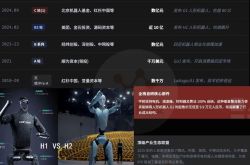"Xiaohongshu's Transformation: Speeding Up for IPO"
![]() 07/24 2024
07/24 2024
![]() 534
534

Recently, the globally renowned financial media outlet Financial Times disclosed a compelling news: Xiaohongshu successfully sold part of its old shares for up to US$17 billion (approximately RMB 120 billion). This transaction not only attracted DST Global to enter the fray for the first time but also prompted Sequoia China to increase its stake, welcoming heavyweight investors such as Hillhouse Capital, Boyu Capital, and CITIC Capital.
Although this valuation represents a pullback from the US$20 billion valuation in 2021, compared to Xiaohongshu's previous funding round, its valuation still achieved a steady growth of approximately US$3 billion, reigniting heated discussions about Xiaohongshu's IPO process.
DST Global, a radical investment institution known for its "high price, few conditions, and no control aspirations," has established a remarkable track record in the global internet sector since its establishment in 2005, with an investment portfolio covering tech giants like Facebook, Twitter, and Snapchat.
Since 2012, its strategic focus has shifted to the Chinese market, successfully investing in numerous industry leaders including JD.com, Alibaba, Xiaomi, Didi, Toutiao, and Meituan, becoming one of the most active US dollar funds in China with a profound understanding and unique perspective on the Chinese internet market.
Currently, the mobile internet market has entered a new phase of stock competition, and Xiaohongshu, as a force to be reckoned with, is attempting to break this stalemate and accelerate its commercialization process.
However, behind the glamorous financing and valuation growth, Xiaohongshu also faces multiple challenges, including organizational adjustments, debates over personnel efficiency ratios, and a pending IPO plan. In particular, the pace of its e-commerce business development appears relatively slow compared to other industry leaders, undoubtedly adding uncertainty to Xiaohongshu's future development.
Xiaohongshu is not slowing down; it is striving to shed the label of "laid-back" growth and actively embrace the tide of commercialization. As the era of rapid internet development gradually comes to an end, whether Xiaohongshu can emerge as a game-changer after Douyin and Pinduoduo remains to be seen.
In this "high-stakes gamble" involving both new and old capital, Xiaohongshu's future is full of unknowns and possibilities.
01
Xiaohongshu Starts Making Money
Xiaohongshu's latest valuation has reached US$17 billion, an increase of US$3 billion compared to 2023. Behind this valuation increase is the significant acceleration of Xiaohongshu's commercialization process and robust performance growth.
In 2023, Xiaohongshu ushered in a highlight moment of development, with monthly active users growing 20% year-on-year to exceed 312 million, and achieving profitability for the first time. Annual revenue soared 85% to US$3.7 billion, with a net profit of US$500 million, completely reversing the previous year's loss of US$200 million.
Looking back at Xiaohongshu's financing history, it is star-studded. Since its inception, Xiaohongshu has completed seven funding rounds, raising over US$900 million, attracting renowned investors such as ZhenFund, GSR Ventures, Jiyuan Capital, and Tencent Investment. Xiaohongshu securely holds the tenth position on Hurun's "China's Top 10 Unicorns 2024" list.
Xiaohongshu's valuation has also climbed steadily: from US$5 billion in 2019 to US$20 billion in 2021. However, subsequently, market doubts about its overvaluation emerged, mainly centered on concerns about advertising dependence.
Against this backdrop, Xiaohongshu's valuation underwent a period of adjustment. In September 2023, Sequoia China, which had not previously held shares in Xiaohongshu, suddenly made a move, becoming a shareholder at a valuation of approximately US$14 billion, 30% lower than the previous funding round. This move quickly sparked a chain reaction within the investment circle, with multiple investment institutions following suit, privately exploring opportunities to purchase Xiaohongshu shares at a slightly higher price than US$14 billion.
This time, Xiaohongshu's profitability directly contributed to the rebound in valuation. The profitable Xiaohongshu attracted the attention of a large number of potential investors, opening a new financing window.
Industry experts point out that in the current Chinese internet market, platforms like Xiaohongshu, with phenomenal scale and growth potential, are rare, making them the target of numerous VC/PE firms. They either seek opportunities for old share transfers or look forward to securing a spot in new funding rounds, making Xiaohongshu a hot commodity in the market.
Regarding shareholder exits, the industry also has its reasonable explanations. Some early investors have accompanied Xiaohongshu through years of ups and downs, and facing the dual considerations of IPO prospects and capital liquidity, some shareholders choose to cash out and leave, which is understandable. After all, some investors are short on funds and unwilling to wait any longer for Xiaohongshu.
"Xiaohongshu is not short of money, but some early investors have exit needs, while new investors are actively joining, leading to this series of transactions," said an investor close to Xiaohongshu. Shen Meng, a director at Cansong Capital, also noted that the transfer of old shares cannot be considered financing as the funds flow between shareholders, without any capital inflow to the company. This round of equity transfers can be seen as a form of compensation for existing investors while also injecting new momentum into Xiaohongshu's IPO process.
It is worth noting that although Xiaohongshu's officials have repeatedly denied having a definite IPO plan, market speculation and anticipation about its IPO have never ceased. From the United States to Hong Kong, rumors of Xiaohongshu's IPO have been rampant, although none have materialized, its proximity to the capital market has kept everyone on tenterhooks.
A decade of grinding, Xiaohongshu has witnessed the rise and fall of China's mobile internet. Now standing at a new historical starting point, it may be just one step away from the milestone of an IPO.
02
Xiaohongshu's Staff Layoffs and Expansion: What's the Plan?
Xiaohongshu, once a platform centered on content communities, is undergoing profound transformation and adjustment under the pressure of going public in recent years. Facing urgent commercialization needs, Xiaohongshu has carried out drastic reforms to its strategy, business segments, and organizational structure, with e-commerce business being particularly prominent, evolving from an auxiliary role to the focus of the company's development.
Since last year, Xiaohongshu has accelerated its layout in the e-commerce sector with continuous actions.
First, the live streaming business was upgraded to an independent department, achieving unified management of live streaming content and e-commerce. Subsequently, e-commerce and live streaming businesses were further integrated to form a new trading department, working alongside the community department and business department to jointly drive the company's commercial development. This year, Xiaohongshu merged buyer operations with merchant operations into an e-commerce operations department, strengthening the integration of its e-commerce segment.
Change often comes with pain. In the process of accelerating commercialization, frequent personnel adjustments and layoffs have ensued at Xiaohongshu. According to reports, Xiaohongshu recently initiated a new round of layoffs, targeting employees whose performance did not meet standards, accounting for up to 30% of the workforce. This is not the first time Xiaohongshu has laid off employees, with previous rounds targeting fresh graduates and probationary employees, raising concerns among employees about job stability and security.
If the previous wave of departures was aimed at cost reduction and efficiency enhancement, this wave of layoffs is related to Xiaohongshu's underwhelming commercial performance during the 618 shopping festival. Frequent changes in senior management and strategic directions have also left employees feeling unprecedented turbulence and unease.
At the same time, Xiaohongshu tends to introduce executives from major companies in personnel appointments, with former executives from companies like Didi and Kuaishou joining successively, injecting fresh blood into the company's key departments such as e-commerce, commercialization, and advertising. In addition, Xiaohongshu's personnel efficiency ratio is still considered insufficient by the new senior management, with a significant gap compared to efficient companies like Pinduoduo.
It is worth noting that while Xiaohongshu is laying off employees, it is also actively recruiting new talent. Thousands of job postings remain on recruitment websites, covering various fields such as sales, evaluation, customer service, and advertising, with competitive salaries, earning the company the nickname "Mini-ByteDance." However, behind the high salaries are the common problems of large companies, such as high employee turnover, intense workloads, and a youthful age structure.
Against the backdrop of parallel layoffs and recruitments, Xiaohongshu demonstrates its urgent pursuit of commercialization and desire to break out of its existing circle. The company hopes to gain more time and space for its IPO by adjusting its business structure and accelerating its commercialization process.
However, on the path to commercialization, Xiaohongshu also faces the challenge of balancing content and commercialization. How to effectively monetize its vast traffic resources while maintaining content quality and user stickiness has become a core challenge for the company.
Data shows that although Xiaohongshu achieved its first profit at the end of 2023, its revenue and net profit still lag far behind competitors like Kuaishou and Douyin. In addition, Xiaohongshu's daily active user growth is also approaching its ceiling, with an annual DAU of only 106 million, far from the year-start target of 140 million.
As user growth nears its ceiling, Xiaohongshu, which has yet to go public, needs a new growth story.
03
How's Xiaohongshu's Commercialization Going?
Xiaohongshu's commercialization journey, like the rich and varied content on its platform, is full of creativity and exploration, as well as twists and challenges. From cross-border e-commerce to self-operated e-commerce, which both suffered setbacks, to the demise of Welfare Society and Little Oasis in 2023, Xiaohongshu's attempts in the e-commerce sector seem to be accompanied by ups and downs.
Since last year, Xiaohongshu has shifted its focus to buyer-based e-commerce and live streaming e-commerce, a transformation that not only reversed the downward trend in performance but also paved a new runway for future commercialization.
Xiaohongshu is well aware of the unique charm of its community culture and has proposed the concept of "buyer-based e-commerce," aiming to tap into and activate mid-tier influencers on the platform with personalized aesthetics and potential for driving sales. This strategy has shown initial success, with the rise of influencers like Dong Jie and Zhang Xiaohui becoming industry legends, especially Dong Jie's "slow live streaming," which unexpectedly became popular, providing valuable experience for Xiaohongshu to create differentiated live streaming benchmarks.
However, in the process of incubating major influencers, Xiaohongshu appears cautious and slow. As the market trend shifts away from "super heads," Xiaohongshu struggles to cultivate native major influencers, and coupled with insufficient user interaction, it lags behind in the fierce market competition. Especially during this year's 618 shopping festival, Zhang Xiaohui's "move to Taobao" incident pushed Xiaohongshu to the forefront of public opinion. Behind this change are both objective factors such as contract expirations and external poaching, as well as the challenges exposed in Xiaohongshu's influencer cultivation, user growth, and content innovation.
In addition, as an innovative attempt by Xiaohongshu, "buyer-based e-commerce" is rooted in the fashion industry, inevitably leading to a relatively narrow audience. However, this model still attracts many bloggers and celebrities, with notable live streaming performances from stars like Wu Xin, Shen Mengchen, and Jiang Sida, contributing substantial transaction volumes to the platform.
Xiaohongshu has not given up on exploring and adjusting the "buyer-based e-commerce" model. It realizes that not all brands and categories can thrive under this model, so it quickly merged buyer operations with merchant operations to form an e-commerce operations department, encouraging store broadcasts to drive overall performance growth. At the same time, Xiaohongshu has increased support for video and live streaming content, especially store broadcasts, which almost enjoy the treatment of "immediate traffic push" upon going live.
In an industry environment where price wars are common, Xiaohongshu's lack of price advantage has gradually become apparent, affecting users' willingness to consume to some extent.
To this end, Xiaohongshu chooses to find a breakthrough from a differentiated perspective, focusing on designer brands and emerging brands, attempting to maintain the platform's "tone" through high-quality, high-price products. However, this strategy also brings limitations, especially in the context of a shift in consumption trends towards cost-effectiveness, Xiaohongshu's high-price products appear somewhat one-sided and difficult to reach a wider range of consumer groups. Zhuang Shuai, founder of Bailian Consulting, candidly stated, "Xiaohongshu's e-commerce may face growth pressure next year."
Xiaohongshu also faces challenges in building commercialization infrastructure.
Multiple merchants have reported that Xiaohongshu's traffic allocation tools are not convenient enough, and its data infrastructure is relatively weak, causing inconveniences in ad placement and order management. In addition, Xiaohongshu's development in supply chain links such as logistics and customer service appears relatively "laid-back," affecting user experience. Coupled with the lack of a transparent data dashboard, merchants have to rely on manual data aggregation to assess ad placement effects, increasing workload and reducing efficiency.
The journey from community to commercialization is full of both opportunities and challenges. Excessive commercialization can damage user experience, while a lack of commercialization channels makes it difficult to retain users and brands, let alone establish a foothold in fierce market competition. Therefore, Xiaohongshu needs to find a delicate balance between community content, brand tone, and e-commerce business. While slow live streaming is a highlight, it is not everything; Xiaohongshu needs to continuously innovate to meet the diverse needs of users and brands in more ways.
In the current mobile internet environment, the golden age of capital appreciation has gradually faded, and the path to IPO for unicorns has become increasingly difficult. Although Xiaohongshu's valuation has increased, creating a new capital myth still requires more efforts.
According to QuestMobile data, Xiaohongshu has become the largest third-party content platform after Alibaba, ByteDance, and Tencent in terms of user scale. However, objectively speaking, there is still a gap between the infrastructure capabilities of its commercialized products and the current commercialization speed, which requires Xiaohongshu to accelerate its commercialization capabilities while maintaining its brand tone to compete in an increasingly fierce market and ensure a stable and sustainable future.







